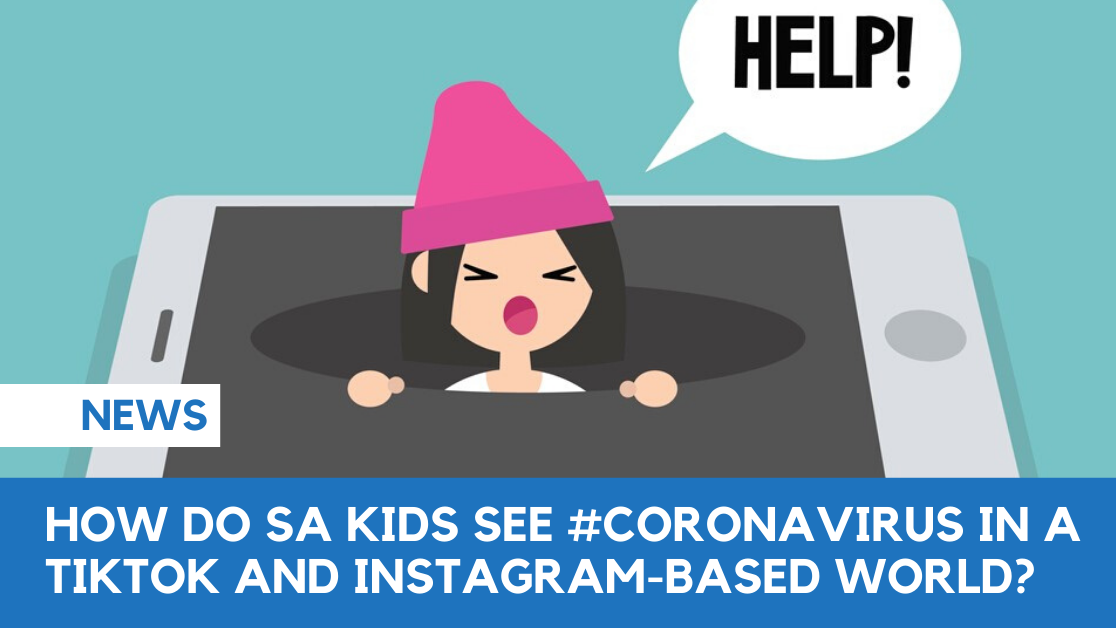As Covid-19 has exploded from a distant reality in South Africa to a global pandemic, with increasing local cases of the virus, we can count ourselves lucky to have almost instant access to information, education and updates on the status of disease. However, the sheer volume of information – fact based or hysteria-driven – can be overwhelming, even for adults. What does this information and the adults’ concern look like to our kids, and how are they consuming information on apps like TikTok, Instagram, or Snapchat?
SA’s leading digital life skills expert, Dean McCoubrey, whose company MySociaLife teaches an 8-module social media program in SA schools, explains that the skill of critical thinking – the ability to question what may be true or false, safe or dangerous, right or wrong – is a key life skill in an explosive world of self-publishing, fake news, and cyberbullying. Consider how much time some teens (and even pre-teens spend online), what is interpreted and then discussed at school, irrespective of whether it may be fake news. Early cases of the virus have seen online hate and memes on some apps towards those with the virus.
Children and teens need to be guided about how to choose what content they consume about the disease, in addition to ongoing engagement with the adults they trust. Schools and parents often overlook the source of their children’s news.
“We’ve got more access to information about Covid-19 thanks to the internet and social media than we’ve had for any other global epidemics such as SARS, MERS and the various Ebola outbreaks, which is helping to manage and treat it,” MCoubrey says.

“The challenge with social media is that it can magnify our herd mentality. And anyone and everyone can publish information which may not be true or negative in a bid to get traction. In the middle of this are our children, who have yet to develop the ability to discern fake news from important facts, and can become overwhelmed or anxious if they are exposed to the wrong information.”
There are a number of steps that parents can take to reassure children, discuss the implications of the disease, and equip them to self-manage their access to information. These include:
- Equip yourself with information from trusted resources, like UNICEF, the World Health Organisation, the US Centre for Disease Control, and the South African Department of Health. Explain that many other sources are less reliable, and check the date of articles and authors – are they credible, or does the headline and image look like fear-mongering ‘clickbait’?
2. Keep calm where possible, because children pick up on their parents’ emotions and are more likely to panic if their parents are doing so.
3. Ask your children what they’ve heard about Covid-19, and answer as many of their questions in age-appropriate ways as you can. If you don’t know the answer to a question, use the opportunity to research it on trusted resources together.
4. Co-create a plan of action – it helps them feel like they’re in control. Teach them the steps that they can take to protect themselves and others, including washing hands frequently with soap or an alcohol-based hand-rub, covering their mouth when sneezing or coughing, or doing so into the elbow, avoiding sick people, and alerting adults if they feel sick so that medical attention can be sought.
5. Share the facts to help them gain an understanding of the role that they play in society. For example, research shows that very few children get really sick or die from the virus, which may make children feel invincible. However, remind them that they can carry the virus and share it people who are vulnerable, like their grandparents.
6. Talk about the social implications of the disease, and remind children that the disease doesn’t care what the people it infects look like – and that there’s no basis for stigmatizing any population group because of the disease. Remind them that everybody looking out for one another and working together is how diseases like Covid-19 are overcome.
7. Keep the conversation going – Covid-19 is here for a while, so consistency is essential. Challenges provide opportunities to educate so do some online research on resources that you’ve identified as trustworthy, and discuss developments regularly and openly.
“Because we teach eight hours of life online to thousands of kids every year, we are closer to understanding how teens and tweens consume content online, interpret what they see and read, and how it impacts them (both positively and negatively).”
MySociaLife’s ‘Digital Life Skills Program’ equips children with the skills they need to be responsible digital citizens, able to discern fake news from real, explains the effect of cyberbullying, shows how to protect privacy and reputation online, and how our mind and body reacts to what we see which can cause mental health issues,” says McCoubrey.
“As devices become increasingly ubiquitous, the issue is becoming less about policing children’s screen time or access to digital content, because they’ll find a way to get online – it’s more about equipping them to think critically about the information they read, so that they can participate actively in their media consumption, rather than accepting everything that they read as the truth,” he adds. “Once they have that distance to question what happens online, we can teach them about other key topics like respect, empathy, resilience and responsible publishing. In one sense they need a digital values system to call on, but you can’t find that in a curriculum here in our country. That’s why we developed our own working with a global entity, resulting in eight 60-minute sessions to unpack it carefully. Schools need the help. And so do many parents – it’s a complex world out there.”




